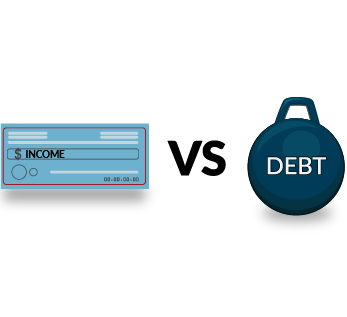Section 1.2
What Is DTI, and Why Is It Important?
Another basic, but still important, part of getting a home loan is understanding your debt-to-income ratio, which is also referred to as your DTI.
In this article, we'll explain exactly what your DTI is, how it's calculated, how to improve it, and how it relates to residual income, another aspect of your finances.

What is DTI (Debt-To-Income)?
DTI is a calculation that compares your pre-tax (or gross) monthly income against your monthly debt load. Essentially, it looks at how much of your income goes to pay off monthly debts.
If you have a high DTI ratio, where most of your income is going towards debts, lenders know that a mortgage could make that debt load too high for you to handle. Conversely, a low DTI shows that you will likely have enough income each month to cover your mortgage and all of your other debts.
Basically, it's used as a kind of guideline that helps evaluate the likelihood of being able to repay your mortgage.
Each type of loan program all have a recommended DTI ratio for potential borrowers. For VA loans, you'll usually want to stay at 40% DTI or below. While the VA doesn't have a set maximum DTI, lenders are required to give additional scrutiny to potential borrowers with a DTI of 41% or more.

Two Types of DTI
In the mortgage world, there are two types of DTI ratios: front-end and back-end.
The Front-End
The front-end ratio only compares your gross monthly income to your projected mortgage payment. None of your other debts are factored in, which is why most mortgage lenders aren't as concerned about this version of DTI.
The Back-End
Back-end, DTI, however, is usually what they take a look at. Because it considers all of your other debts in addition to your projected mortgage payment, it offers a fuller, more realistic picture of your debt load.
Back-end DTI allows your lender and you to consider how your monthly debts might be affected by adding in a mortgage.

How to Calculate DTI
Before getting a mortgage, it can be a good idea to do your own loose DTI calculation to start figuring out what kind of house payment you might be comfortable with. But first you need to know the factors that are included as part of the DTI calculation.
A majority of the debts included into the back-end ratio are pulled from your credit report. These include:

Car payment(s)

Student loan payment(s)

Minimum credit card payment(s)

Personal loan payment(s)

Child support payments

Alimony payments

Wage garnishments

Projected mortgage payment*

Projected homeowners insurance

Projected property taxes

Projected HOA fees
As you can see, a majority of the debts factored into the back-end ratio are pulled from your credit report. However, there are a few debts, like child support and alimony, that are pulled from other sources.
In addition, not all of the debts listed on your credit report will be included. Things like collections and charge-offs aren't counted, unless you're making regular monthly payments on them.
The key words just now were regular and monthly. Only debts that occur on a consistent, monthly basis get included. They also have to be required debts that you must pay off, which is why your minimum payment is what's calculated and not the account balance or the amount you typically pay.
Finally, before we move on to the actual math portion of the calculation, it's important to note that not everyone will have all of these debt types. Maybe you don't have a car, for example, or it's already been paid off. Or you don't have alimony payments you've been ordered to make to a former spouse.
If that's the case for any of the debts listed above, you simply don't include that item in your debt calculation.
Example DTI Calculations
When it's time to actually crunch the numbers, the DTI calculation is very straightforward and involves simply addition and division. Basically, all you do is add together all of your applicable debts from the list above and then divide them by your gross monthly income.
As an example, let's say your gross monthly income is $5000, and all of your monthly debts break down as follows:
- Car payment: $250
- Student loan payment: $100
- Minimum credit card payments: $100
- Personal loan payments: $0
- Child support payments: $0
- Alimony payments: $0
- Wage garnishments: $0
- Projected mortgage payment: $1100
- Projected homeowners insurance: $100
- Projected property taxes: $100
- Projected HOA fees: $0
If we add all of that up, your total monthly debt load is $1900. In the next step of the calculation, we'll take that amount and divide it by $5,000, which is your gross monthly income in this example. This comes out to 0.38, which means your backend DTI ratio in this example is 38%.
As we mentioned earlier, VA loans prefer borrowers to stay under 40% DTI, so in this example, your loan application would be able to avoid additional scrutiny from the lender.
What If My DTI Is Too High?
In the above example, let's say your total monthly debt load ended up being $2100 instead of $1900. This would give you a back-end DTI of 42%
As we mentioned earlier, any DTI above 41% would trigger additional scrutiny of your finances in order to make sure you truly could afford the mortgage.
Oftentimes, this scrutiny takes a closer look at your income and how much of it you have left over each month after paying all of your debts, including your projected mortgage payment.
In the world of VA home loans, this type of income evaluation is called residual income. Though residual income plays a role in every VA loan, regardless of DTI level, it takes on additional importance for borrowers with high DTIs.
Basically, if you have enough of a residual income left over, despite your high DTI, it can serve as a "compensating factor" that makes approval for the loan easier, even if you don't reduce your DTI.
Residual Income

What is Residual Income?
Like DTI, residual income is a calculation that compares your debts to your monthly income. They are very closely related, and they even use the same debts in their calculation.
However, the difference between the two is how they are calculated. If you remember, DTI is calculated by dividing your total debts by your gross income. Residual income, on the other hand, is calculated by subtracting your total debts from your net income.
The result of this calculation ends up being how much discretionary income you're projected to have left over each month after all your debts are paid.
How Residual Income Can Compensate for High DTI
As we mentioned before, having enough residual income left over each month can serve as a compensating factor for a high DTI.
But what exactly is "enough"?
According to the VA, you can avoid even more additional scrutiny of your mortgage application if your residual income exceeds their recommended guideline by at least 20%
These guidelines are published by the VA and are determined by two factors:
- The geographic area of the home
- The size of your family
For loan amounts above $80,000, these residual income requirements are as follows:
| Family Size | Northeast | Midwest | South | West |
|---|---|---|---|---|
| 1 | $450 | $441 | $441 | $491 |
| 2 | $755 | $738 | $738 | $823 |
| 3 | $909 | $889 | $889 | $990 |
| 4 | $1025 | $1003 | $1003 | $1117 |
| 5 | $1062 | $1039 | $1039 | $1158 |
| 6 | $1142 | $1119 | $1119 | $1238 |
| 7 | $1222 | $1279 | $1279 | $1318 |
So, based on this chart, if you have a family of 4 in Louisiana and your DTI is at 42%, you'd need $1,203.60* each month in residual income in order for it to serve as a compensating factor.
Using the DTI Calculation Before the Home & Mortgage Search
While VA lenders use your debt-to-income ratio to help them determine if you'll likely be able to afford the mortgage you want, you can also use it to help yourself figure out how much of a house you could practically and realistically afford.
Now that you know how the calculation works, you can figure out what your comfortable, ballpark range is for what you want to spend on a home each month before even talking with a lender or looking at a home.
However, if you'd still like some help figuring out our DTI, our loan officers are always happy to help. Giving us a call is free, and there's never any obligation to keep working with us afterwards.
 Text Us
Text Us Call Us
Call Us
